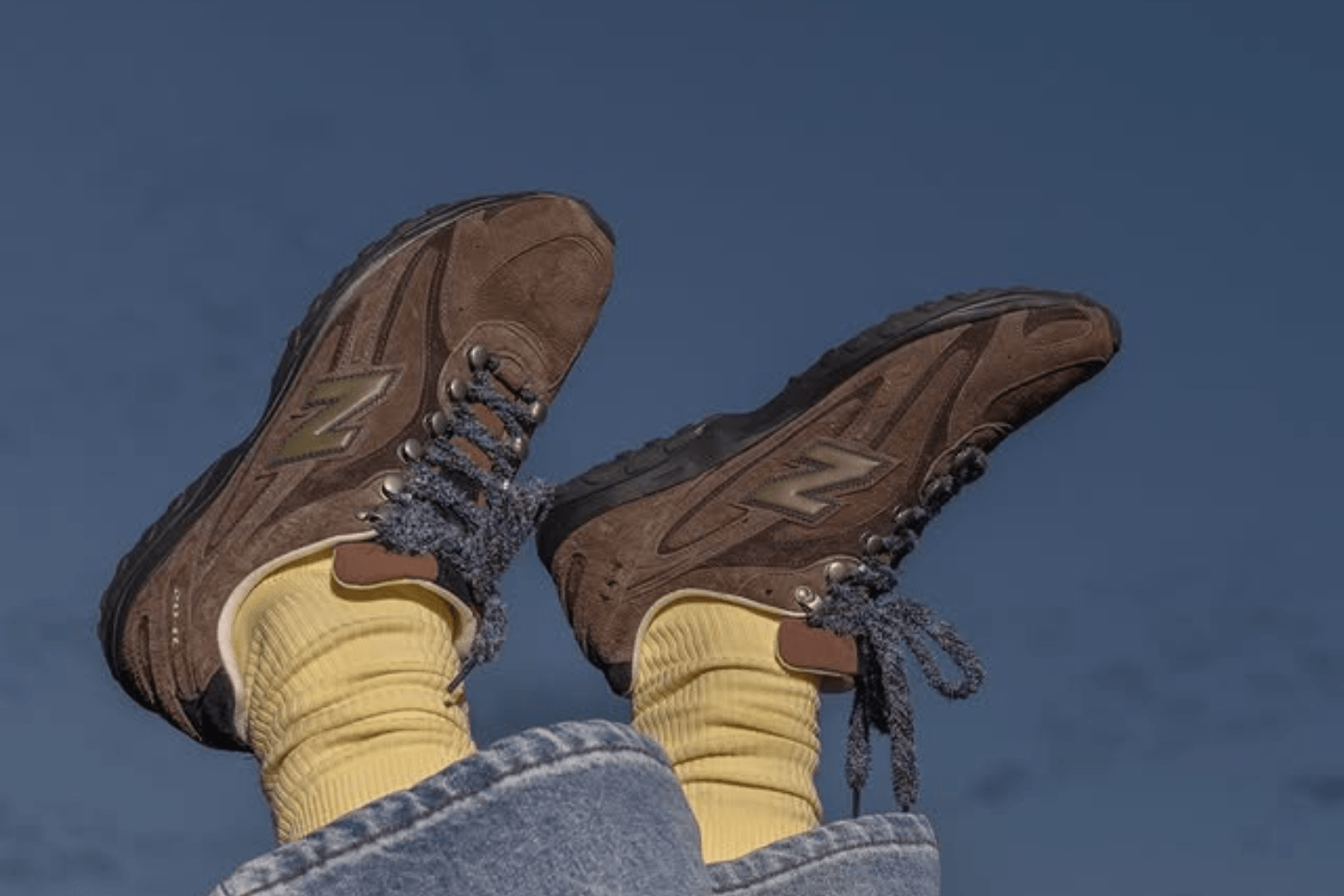It is estimated that the sneaker and fashion industry is responsible for 6% of Europe's total carbon footprint. If the industry continues like this, the climate impact is expected to increase by another 49% by 2030.
The core of the industry, in short, is its reliance on common plastics. This means that 99% of plastics come from fossil fuels - and these fuels are the main source of carbon emissions. 91% of all plastics worldwide are not recycled after their production and end up in landfills or in the ocean.
Sustainability is an important issue and luckily, the sneaker industry has already taken several steps in this direction. When we talk about sustainability, we generally mean being able to utilise the value of an item as much and for as long as possible.
What is Sustainable Footwear?
Sustainable shoes are made from eco-friendly materials and have a minimal environmental impact during production.
Sustainable materials
A growing focus is being placed on using sustainable materials in sneakers, such as recycled plastics, plant-based alternatives, and organic cotton. Brands are also experimenting with materials like sugarcane-based foam, mushroom leather and recycled rubber in order to minimise environmental impact while maintaining performance.
By using sustainable materials, greenhouse gas emissions associated with traditional sneaker production can be significantly lowered, and the reliance on fossil fuels reduced.

Sustainable lifecycle
A typical pair of sneakers has a carbon footprint of around 13.6 kilograms of CO₂ emissions, with more than two-thirds of the carbon impact coming from the manufacturing process. A significant portion of shoe manufacturers are located in China, where coal is the dominant fuel source.
In an effort to mitigate these emissions, some brands have began to introduce models with lower carbon footprints by optimising manufacturing processes and utilising sustainable materials.
By reducing energy consumption, minimising waste, and streamlining supply chains by shifting towards local sourcing and manufacturing, companies are able to make a significant move towards environmental responsibility in their footwear.
What is Greenwashing?
Greenwashing is when a company tries to appear particularly sustainable through marketing measures. It is also known as a ‘green image’. It should be noted here that the sustainable statements made by companies are usually true in essence - but the core business is usually not environmentally friendly.
Many companies and brands in the sneaker scene are taking many important steps towards greater sustainability. Nevertheless, the topic is very complex and being REALLY sustainable is unfortunately still almost impossible in many cases.
What are the most Sustainable Footwear Brands?
VEJA
VEJA is a French sneaker brand that blends minimalist design with maximum transparency. Since its launch in 2005, VEJA has prioritised ethical sourcing and sustainable practices. The brand uses organic cotton from Brazil and Peru, wild Amazonian rubber for soles (helping protect the rainforest from deforestation), and innovative recycled materials such as plastic bottles spun into mesh. Their supply chain is fully traceable, and VEJA works directly with farmers and factories, paying above-market prices to ensure fair labor and environmental care.

Allbirds
Allbirds, based in the USA, has become a go-to for eco-conscious consumers thanks to its commitment to carbon neutrality and materials innovation. Allbirds crafts its shoes from natural and renewable sources like merino wool, eucalyptus tree fibers, and SweetFoam™—a sugarcane-based midsole foam. Allbirds goes beyond carbon reduction by labeling the carbon footprint of each product and offsetting their emissions. They're also exploring regenerative agriculture and low-energy manufacturing to push sustainability even further.

NAE
NAE (No Animal Exploitation) is a Portuguese vegan footwear brand with a name that reflects its mission: to create stylish shoes without harming animals or the planet. NAE uses a variety of innovative and sustainable materials such as Piñatex (a leather-like fabric made from pineapple leaves), cork, recycled PET bottles, and bio-based alternatives. All products are made in certified ethical factories in Portugal, ensuring fair wages and clean working conditions.

Rothy's
Rothy's transforms single-use plastic into chic, durable shoes, bags, and accessories. Each pair of Rothy’s shoes is made using a 3D knitting process that eliminates waste, and the uppers are constructed from recycled plastic water bottles and ocean-bound marine plastic. Even the insoles and soles incorporate sustainable materials like algae-based foam and recycled rubber.

MoEa
MoEa (Mother Earth) is a brand that merges plant-based innovation with modern sneaker design. Produced in Portugal using renewable energy, MoEa sneakers are made from sustainable materials like grape leather (a byproduct of winemaking), apple skin, cactus, corn, and pineapple fibers. They pair these bio-based uppers with recycled and natural rubber soles and organic cotton linings. MoEa is climate-neutral and certified vegan, with a mission to offer high-performance footwear with a low environmental footprint.

Flamingo's Life
Flamingo’s Life is a Spanish sneaker brand deeply rooted in vegan ethics and environmental action. Their designs blend retro aesthetics with modern sustainability, using natural and bio-based materials such as corn waste, bamboo, hemp, and organic cotton. Every pair is handcrafted in family-owned factories in Spain under fair labor practices. Beyond materials, Flamingo’s Life partners with reforestation and clean water NGOs—each purchase helps plant trees or build wells in developing countries.

Which Brands are moving towards a sustainable future?
Nike
Launched in September 2019, Nike’s Move To Zero initiative is the brand’s journey to achieving zero carbon emissions and zero waste. Key targets were set for 2025 including:
- Carbon Neutrality: Nike aimed to make its own operations and supply chain carbon neutral by 2025.
- Circular Economy: Nike aimed to stop landfilling by 2025 and instead reuse all waste through recycling or incineration with energy recovery.
- Water Management: Nike aimed to reduce water consumption in its supply chains by 25% by 2025.
- Fairness and Equality: Nike aimed to make its supply chain fairer by 2025 and ensure that all workers are treated fairly, including fair pay and safe working conditions.
- Sustainable Materials: Nike set a target to source at least 50% of materials used from sustainable sources by 2025.
As of today, Nike has made notable progress towards its targets, including a 78% reduction in greenhouse gas emissions, and 99.7% of their manufacturing scraps being diverted from landfills through recycling. Other goals remain in progress, with ongoing initiatives focused on material innovations, supply chain efficiency, and circular design principles.

A new chapter in Nike’s Move To Zero campaign, the One Box project was announced in 2022, in which sneakers would no longer be double-boxed.
The One Box combines the shoe box and packaging used to ship the sneaker in one design, reducing cardboard waste by functioning as both a shoe box and shipping box. Compared to previous Nike packaging, One Box offers a 51% reduction in waste for individual online orders, regardless of the shoe inside.

The ‘Nike Grind’ program, established in 1994, recycles residual materials from the production of Nike shoes and apparel and uses them to make new products.
Furthermore, Nike's Reuse-A-Shoe program collects around 1.5 millions pairs of worn-out shoes annually, diverting them from landfills, and extracts rubber, foam and fibre from the shoes to be ground into granules as part of the Nike Grind program. These are then incorporated into footwear and apparel, amongst other things like sports surfaces and building materials.
The Nike Space Hippie was introduced in 2020, and is a line of sneakers that emphasise sustainability by utilising these recycled materials. The Space Hippie collection is a significant step towards reducing the carbon footprint in sneaker manufacturing.
It offers customers an eco-friendly option with uppers made from between 85-90% recycled content, midsoles made from Crater Foam, and insoles that utilise ZoomX foam scraps.

Nike’s Next Nature collection features footwear and apparel that incorporate recycled materials. Classic Nike designs like the Air Force 1 and Dunk are reimagined with eco-friendly materials that don’t compromise on performance or style.
Each product in the Next Nature collection is made with at least 20% recycled content by weight.

adidas
adidas worked with environmental organisation Parley for the Oceans from 2015 - 2024. Focusing on ocean conservation and addressing the escalating issue of marine plastic pollution, the adidas x Parley collaboration aimed to transform plastic waste retrieved from the oceans into sportswear products.
In the Primeblue collection, models including the Ultraboost and NMD_R1 were given a sustainable production process, made from recycled plastic yarn.
By 2020, the collaboration resulted in the production of 15 millions pairs of shoes made from recycled ocean plastic, effectively removing over 7,000 tons of plastic waste from marine environments.
Although adidas ended its partnership with Parley for the Oceans in 2024, through initiatives like Run for the Oceans, the collaborations fostered global awareness and activism that has set a precedent for future sustainable practices within the sportswear industry.

ASICS
By building transparent, fair and ethical partnerships in the supply chain, ASICS can focus on production processes, sustainable design, and using the right materials to make a positive contribution to global climate goals.
ASICS supports their planet-focused efforts with a circular approach, reducing material use, reusing materials, and producing durable products with a longer lifespan.The brand aims to find more sustainable alternatives to non-sustainable materials and processes by 2030, including polyester, leather, and cotton, as well as a 63% reduction in CO2 emissions.
ASICS’ shoes with the sunflower icon have an upper made from scrap materials or at least 30% recycled materials, and the clothes are made from scrap materials or at least 50% of the main material is recycled.

CNF (cellulose nanofibre) is a bio-based material that’s used in the sole of ASICS shoes. As it can be produced from almost any type of plant biomass, it’s an abundant and renewable resource, and by integrating it in their shoes, ASICS aims to reduce their ecological footprint.
One example of an ASICS model with CNF is the Gel-Kayano 25. Other sustainable models include the Gel-Kayano 30, which as a mesh upper that is about 70% recycled, and the Court FF 3, which is made from durable, bio-based materials. The Gel-Lyte III CM 1.95 has the lowest CO2 emission on the market.
Converse
Actively pursuing sustainability through various initiatives, Converse launched the notable Converse Renew line in 2019, reimagining classic models like the Chuck Taylor All Star and Chuck 70 with incorporated recycled and upcycled materials.
Renew Canvas is crafted from 100% recycled polyester derived from plastic bottles, while Renew Denim repurposes discarded denim jeans into unique sneaker uppers. Renew Cotton involves recycling cotton canvas waste from the manufacturing process and weaving it into new material.
Converse has also explored innovative retail concepts, like the Renew Labs in Melbourne. This sustainability-focused space offers workshops on product customisation using eco-friendly methods, as well as services for cleaning, repair, and renewal of sneakers.

New Balance
New Balance introduced their Green Leaf standard to highlight products made with environmentally preferred materials, including their footwear that contains at least 50% of these materials like recycled polyester in their upper.
By 2030, the brand aims to source 80% preferred midsole and 90% preferred outsole compounds, incorporating bio-based EVA from sugarcane and recycled midsole foam.

VANS
Actively advancing their sustainability efforts through various initiatives and product lines, VANS is aiming to reduce their environmental impact through their Eco Theory line and VR3 Collection. By 2030, VANS aims for 100% of their top four CO₂ impact materials (cotton, polyester, leather, and rubber) being regenerative, responsibly sourced, renewable, or recycled.
Eco Theory Authentic sneakers feature uppers made from 100% certified organically grown cotton canvas, laces crafted from natural hemp fibres, and outsoles made from responsibly sourced natural rubber.
The VR3 collection are made from at least 30% renewable, regenerative or recycled materials. VANS uses latex largely sourced from regenerative agriculture to ensure the protection of biodiversity, improve water quality and sequester carbon. At least 25% of the soles are made from bio-based EVA foam in the midsole and integrated natural rubber in the outsole.








